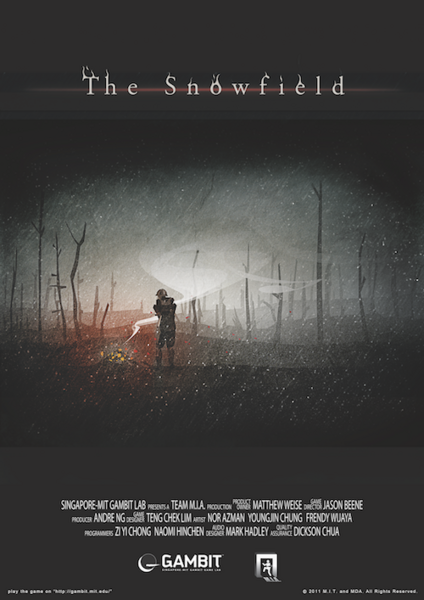A new video game from the Singapore-MIT GAMBIT Game Lab takes interactive storytelling trends to task. Developed by student interns over the summer, "The Snowfield" has just been announced as a finalist in the Student Showcase of the 2012 Independent Games Festival.
The game challenges the notion that simulation-driven interactive stories — the sort depicted in Star Trek's Holodeck — require highly advanced technology to evoke strong emotional and dramatic experiences.
Instead, "The Snowfield" provides evidence for the opposite: that limited tech is an opportunity to address such challenges artistically, leaving space for players to find their own meaning in the workings of a simulation. This approach is more accessible for casual players, even for war games, which are typically the realm of hard-core gamers.
The game was created by team "M.I.A.," a group of 10 student programmers, designers and artists who worked together as part of GAMBIT's 2011 summer program, which brings in students from top universities in the United States and Singapore to conceive, research, and make a game in just eight weeks.
"'The Snowfield' intends to simulate a World War I scenario at the right level of fidelity and abstraction," says Matthew Weise, GAMBIT's game design director. Research on interactive storytelling has moved in the direction of simulating a storyteller, an approach called "drama management." But the problem, Weise says, is in the assumption that players cannot find drama for themselves. "The Snowfield" just tries to give players an optimal amount of raw material for their imaginations to assemble a compelling experience.
- Play "The Snowfield": http://gambit.mit.edu/loadgame/snowfield.php
Singaporean student Teng Chek Lim says his time at MIT offered insight into life in the game industry, especially team-based efforts. He praised how the program advanced his job prospects, adding that as the game designer of "The Snowfield," "actually seeing players 'getting' the idea of the game and enjoy playing it was the best part of making the game for me."
About the team's IGF acknowledgment, Jason Beene, game director for 'The Snowfield', says they are thrilled and honored to be selected for the Student Showcase. "I couldn't think of a better reward for such a hard working and talented team. Knowing that 'The Snowfield' resonated with the panel of judges is prize enough. To be a part of the showcase provides the unique privilege of being shown directly on the Game Developers Conference expo floor this March in San Francisco, exposing our game directly to those whom we desire most to experience it: other inspired game makers. 'The Snowfield' is in great company historically and this year is no exception. We at GAMBIT are delighted."
Additional information
Singapore-MIT GAMBIT Game Lab (gambit.mit.edu)
The Singapore-MIT GAMBIT Game Lab is a research collaboration between the Massachusetts Institute of Technology and the Interactive Digital Media R&D Programme Office hosted by the Media Development Authority of Singapore. The lab experiments with the theory, aesthetics, culture, craft, legacy, technology and play of games, developing, sharing, and deploying prototypes, findings and best practices to challenge and shape global game research and industry. GAMBIT builds collaborations between Singapore institutions of higher learning and MIT departments to identify and solve research problems using a multi-disciplinary approach that can be applied by Singapore's digital game industry.
Media Development Authority (www.mda.gov.sg)
The Media Development Authority of Singapore promotes the growth of globally competitive film, television, radio, publishing, music, games, animation and interactive digital media industries. It also regulates the media sector to safeguard the interests of consumers, and promotes a connected society.






